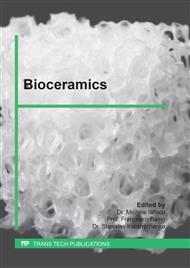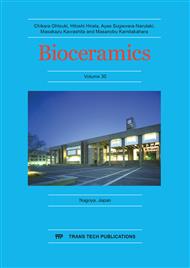[1]
A. Cahyanto, M. Maruta, K. Tsuru, S. Matsuya, K. Ishikawa, Fabrication of bone cement that fully transforms to carbonate apatite, Dent. Mat. J. 34 3 (2005) 394-401.
DOI: 10.4012/dmj.2014-328
Google Scholar
[2]
A. Cahyanto, M. Maruta, K. Tsuru, S. Matsuya, K. Ishikawa, Basic properties of carbonate apatite cement consisting of vaterite and dicalcium phosphate anhydrous, Key Eng. Mater. 529-530 (2013) 192-196.
DOI: 10.4028/www.scientific.net/kem.529-530.192
Google Scholar
[3]
A. Cahyanto, K. Tsuru, K. Ishikawa, Carbonate apatite formation during the setting reaction of apatite cement, Advances in Bioceramics and Porous Ceramics V. Ceramics Engineering and Science Proceeding 336 (2013) 7-10.
DOI: 10.1002/9781118217504.ch2
Google Scholar
[4]
K. Ishikawa, Bone substitute fabrication based on dissolution-precipitation reactions, Materials. 3 (2010) 1138-1155.
DOI: 10.3390/ma3021138
Google Scholar
[5]
A. Cahyanto, I. Permatasari, R. Febrida, Setting time evaluation of injectable carbonate apatite cement using various sodium carboxymethylcellulose concentration, Padjadjaran J. Dent. 30 2 (2018) 74.
DOI: 10.24198/pjd.vol30no2.18321
Google Scholar
[6]
A. Cahyanto, E. Megasari, M. N. Zakaria, et. al, Fabrication of carbonate apatite cement as endodontic sealer, Key Eng. Mater. 758 (2017) 61-65.
DOI: 10.4028/www.scientific.net/kem.758.61
Google Scholar
[7]
S. Tyagi, P. Mishra, P. Tyagi, Evolution of root canal sealers: an insight story, Eur. J. Gen. Dent. 2 (2013) 199-218.
DOI: 10.4103/2278-9626.115976
Google Scholar
[8]
S. Tour Savadkouhi, M. Fazlyab, Discoloration potential of endodontic sealers: a brief review. Iran Endod. J. 11 4 (2016) 250-4.
Google Scholar
[9]
G. Debelian, M. Trope, The use of premixed bioceramic materials in endodontics, Giornale Italiano di Endodonzia, 30 2 (2016) 70-80.
DOI: 10.1016/j.gien.2016.09.001
Google Scholar
[10]
J. K. Lee, S. W. Kwak, J.H. Ha, W.C. Lee, and H.C Kim, Physicochemical properties of epoxy resin-based and bioceramic-based root canal sealers, Bioinorg. Chem. Appl., (2017) 1-8.
DOI: 10.1155/2017/2582849
Google Scholar
[11]
N.A. Allan, R.C. Walton, M.A. Schaeffer, Setting times for endodontic sealers under clinical usage and in vitro conditions, J. Endod. 27 (2001) 421-3.
DOI: 10.1097/00004770-200106000-00015
Google Scholar
[12]
S.J. Ding, C.T. Kao, M.Y. Shie, C.Jr. Hung, T.H. Huang, The physical and cytological properties of white MTA mixed with Na2HPO4 as an accelerant. J. Endod. 34 (2008) 748-751.
DOI: 10.1016/j.joen.2008.02.041
Google Scholar
[13]
B.S. Ber, J.F. Hatton, G.P. Stewart, Chemical modification of proroot mta to improve handling characteristics and decrease setting time, J. Endod. 33 (2007) 1231-1234.
DOI: 10.1016/j.joen.2007.06.012
Google Scholar
[14]
A. Cahyanto, A.G. Imaniyyah, & M.N. Zakaria, Z. Hasratiningsih. Mechanical strength properties of injectable carbonate apatite cement with various concentration of sodium carboxymethyl cellulose. Key Eng. Mater. 758 (2017) 56-60.
DOI: 10.4028/www.scientific.net/kem.758.56
Google Scholar
[15]
R.Z. LeGeros, Apatites in biological system, Crystal Growth Charact. 4 (1981) 1-45.
Google Scholar
[16]
A. Cahyanto, K. Tsuru, K. Ishikawa. Transformation of apatite cement to B-type carbonate apatite using different atmosphere. Key Eng. Mater. 696 (2016) 9-13.
DOI: 10.4028/www.scientific.net/kem.696.9
Google Scholar
[17]
A. Cahyanto, R. Toita, K. Tsuru, K. Ishikawa. Effect of particle size on carbonate apatite cement properties consisting of calcite (or vaterite) and dicalcium phosphate anhydrous. Key Eng. Mater. 631 (2014) 128-133.
DOI: 10.4028/www.scientific.net/kem.631.128
Google Scholar
[18]
A. Cahyanto, K. Tsuru, K. Ishikawa, M. Kikuchi. (2017). Mechanical strength improvement of apatite cement using hydroxyapatite/collagen nanocomposite. Key Eng. Mater. 720 (2017) 167-172.
DOI: 10.4028/www.scientific.net/kem.720.167
Google Scholar
[19]
M.N. Zakaria, A. Cahyanto, A. El-Ghannam. Basic properties of novel bioactive cement based on silica-calcium phosphate composite and carbonate apatite. Key Eng. Mater. 720 (2016) 147-152.
DOI: 10.4028/www.scientific.net/kem.720.147
Google Scholar



